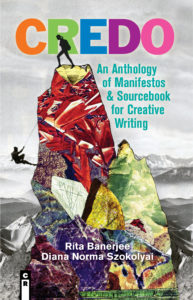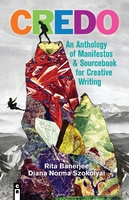 CREDO. I believe. No other statement is so full of intent and subversion and power. A Credo is a call to arms. It is a declaration. A Credo is the act of an individual pushing back against society, against established stigmas, taboos, values, and norms. A Credo provokes. It desires change. A Credo is an artist or community challenging dogma, and putting oneself on the front line. A Credo is art at risk. A Credo can be a marker of revolution. A Credo, is thus, the most calculating and simple form of a manifesto.
CREDO. I believe. No other statement is so full of intent and subversion and power. A Credo is a call to arms. It is a declaration. A Credo is the act of an individual pushing back against society, against established stigmas, taboos, values, and norms. A Credo provokes. It desires change. A Credo is an artist or community challenging dogma, and putting oneself on the front line. A Credo is art at risk. A Credo can be a marker of revolution. A Credo, is thus, the most calculating and simple form of a manifesto.
CREDO creates a bridge from the philosophical to the practical, presenting a triad of creative writing manifestos, essays on the craft of writing, and creative writing exercises. CREDO: An Anthology of Manifestos and Sourcebook for Creative Writing is a raw look at what motivates authors today.

CONTRIBUTING AUTHORS
Kazim Ali \ Forrest Anderson \ Rita Banerjee \ Lisa Marie Basile
Jaswinder Bolina \ Stephanie Burt \ Alexander Carrigan \ Sam Cha
Melinda J. Combs \ Thade Correa \ Jeff Fearnside \ Ariel Francisco
John Guzlowski \ Rachael Hanel \ Janine Harrison \ Lindsay Illich
Douglas Charles Jackson \ Caitlin Johnson \ Christine Johnson-Duell
Jason Kapcala \ Richard Kenney \ Eva Langston \ John Laue \ Stuart Lishan
Ellaraine Lockie \ Amy MacLennan \ Kevin McLellan \ E. Ce. Miller
Brenda Moguez \ Peter Mountford \ Nell Irvin Painter \ Robert Pinsky
Kara Provost \ Camille Rankine \ Jessica Reidy \ Amy Rutten \ Elisabeth Sharp McKetta
David Shields \ Lillian Ann Slugocki \ Maya Sonenberg \ Kathleen Spivack
Laura Steadham Smith \ Molly Sutton Kiefer \ Jade Sylvan \ Anca L. Szilágyi
Diana Norma Szokolyai \ Marilyn L. Taylor \ Megan Jeanine Tilley \ Suzanne Van Dam
Nicole Walker \ Allyson Whipple \ Shawn Wong \ Caroll Yang \ Matthew Zapruder
A LOOK INSIDE
“Symptoms of Prophesy”
Camille Rankine
In the new century,
we lose the art of many things.
For example, at the beep, I communicate
using the wrong machine.
I called to say we have two lives
and only one of them is real.
When the phone rings: you could be anybody.
In the evening: you are homeless
and hunting for good light, as safe a place
as any to make a bed for the night.
In both my lives, my nerves go bust.
I’m certain that I’m not
as I appear, that I’m a figment and
you’re not really here.
The struggle
is authenticity.
I have a message.
You must believe me.
“The First Four Steps”
Caitlin Johnson
One: You Must Read
It isn’t enough to want to tell stories. Every writer is, above all, a reader. If you ever hear someone swear he doesn’t read, be suspicious of anything he writes.
Ray Bradbury’s philosophy was that you should fill yourself up with as much as possible, because the more words you consume, the more likely you are to know what works, what doesn’t; what’s been done, what hasn’t; what kind of writer you want to be, what kind you don’t. And never underestimate the effect someone else’s words might have on you. They may spur you to greatness. But you won’t know if you don’t read their work.
For this reason, I tend to seek out a wide variety of titles, from celebrity memoirs to classic young adult works, contemporary poetry to historical biographies, and anything else that catches my eye. Even when a book isn’t doing it for me, I try not to give up on it, because finishing it helps me better understand what I dislike about the work, and also helps encourage me to power through my own drafts when I feel I’m on the wrong track. To put it another way, we must practice a sort of fortitude that we may not apply in other areas of our lives in order to learn something about our writing…
“Collage and Appropriation”
David Shields
Origin Myth #1
I’m not a big believer in Major Epiphanies, especially those that occur in the shower, but I had one, and it occurred in the shower. Working on Handbook for Drowning: A Novel in Stories, I had the sudden intuition that I could take various fragments of things—aborted stories, out-takes from novels, journal entries, lit-crit—and build a story out of them. I really had no idea what the story would be about; I just knew I needed to see what it would look like to set certain shards in juxtaposition with other shards…
